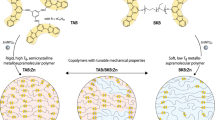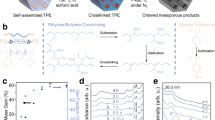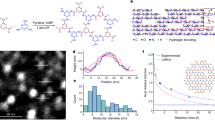Abstract
With an annual production of hundreds of millions of tons, the few commodity polymers that dominate the plastics market cannot satisfy all the applications and expectations. In this context, the fabrication of thermodynamically stable polymer blends structured on submicrometre scales raises much hope, but poses significant scientific and industrial challenges. Here, we propose and demonstrate for an industrially relevant system, polyethylene and polyamide, that hitherto inaccessible co-continuous morphologies can be produced over a wide range of compositions by reactive blending. Paradoxically, the self-assembled structures are thermodynamically stable because of the molecular polydispersity inherent in the production method. These nanostructured materials present a unique combination of properties impossible to achieve with classical blends. This versatile, low-cost and simple strategy should be widely applicable.
This is a preview of subscription content, access via your institution
Access options
Subscribe to this journal
Receive 12 print issues and online access
$259.00 per year
only $21.58 per issue
Buy this article
- Purchase on Springer Link
- Instant access to full article PDF
Prices may be subject to local taxes which are calculated during checkout




Similar content being viewed by others
References
Utracki, L.A. Polymer Alloys and Blends (Hanser, New York, 1989).
de Gennes, P.G. & Taupin, C. Microemulsions and the flexibility of oil/water interfaces. J. Phys. Chem. 86, 2294–2304 (1992).
Bates, F.S. et al. Polymeric co-continuous microemulsions. Phys. Rev. Lett. 79, 849–852 (1997).
Fredrickson, G.H. & Bates, F.S. Design of co-continuous polymeric microemulsions. J. Polym. Sci. Part B: Polym. Phys. 35, 2775–2786 (1995).
Hillmyer, M.A., Maurer, W.W., Lodge, T.P., Bates, F.S. & Almdal, K. Model co-continuous microemulsions in ternary homopolymer/block copolymer blends. J. Phys. Chem. B 103, 4814–4824 (1999).
Washburn, N.R., Lodge, T.P. & Bates, F.S. Ternary polymer blends as model surfactant systems. J. Phys. Chem. B 104, 6987–6997 (2000).
Fredrickson, G.H. & Bates, F.S. Stabilizing co-continuous polymer blend morphologies with ABC block copolymers. Eur. Phys. J. B 1, 71–76 (1998).
Orr, C.A., Adedeji, A., Hirao, A., Bates, F.S. & Macosko, C.W. Flow-induced reactive self-assembly. Macromolecules 30, 1243–1246 (1997).
Lyu, S.-P. Cernohous, J.J., Bates, F.S. & Macosko, C.W. Interfacial reaction induced roughening in polymer blends. Macromolecules 32, 106–110 (1999).
Charoensirisomboon, P., Inoue, T. & Weber, M. Interfacial behavior of block copolymers in situ-formed in reactive blending of dissimilar polymers. Polymer 41, 4483–4490 (2000).
Ibuki, J. et al. Reactive blending of polysulfone with polyamide: a potential for solvent-free preparation. Polymer 40, 647–653 (1999).
Charoensirisomboon, P., Chiba, T., Solomko, S.I., Inoue, T. & Weber, M. Reactive blending of polysulfone and polyamide: a difference in interfacial behavior between in situ formed block and graft copolymers. Polymer 40, 6803–6810 (1999).
Oyama, H.T., Ougizawa, T., Inoue, T., Weber, M. & Tamaru, K. Interfacial coupling between immiscible polymers: reactive interface between polysulfone and amorphous polyamide. Macromolecules 34, 7017–7024 (2001).
Yin, Z., Koulic, C., Pagnoulle, C. & Jerome, R. Reactive blending of functional PS and PMMA: interfacial behavior of in situ formed graft copolymers. Macromolecules 34, 5132–5139 (2001).
de Gennes, P.G. Conformations of polymers attached to an interface. Macromolecules 13, 1069–1075 (1980).
Milner, S.T., Witten, T.A. & Cates, M.E. Effects of polydispersity in the end-grafted polymer brush. Macromolecules 22, 853–861 (1989).
Thompson, R.B. & Matsen, M.W. Improving polymeric microemulsions with block copolymer polydispersity. Phys. Rev. Lett. 85, 670–673 (2000).
Pernot, H. Thesis, Univ. Pierre et Marie Curie (Paris 6), in preparation.
Leibler, L. Emulsifying effects of block copolymers in incompatible polymer blends. Makromol. Chem.-M. Symp. 16, 1–17 (1988).
Pochan, D.J. et al. Morphologies of microphase-separated A2B simple graft copolymers. Macromolecules 29, 5091–5098 (1996).
Loo, Y.-L., Register, R.A., Ryan, A.J. & Dee, G.T. Polymer crystallisation confined in one, two or three dimensions. Macromolecules 34, 8968–8977 (2001).
Loo, Y.-L., Register, R.A. & Ryan, A.J. Modes of crystallisation in block copolymer microdomains: breakout, templated, and confined. Macromolecules 35, 2365–2374 (2002).
Xu, J.-T. et al. Morphological confinement on crystallisation in blends of poly(oxyethylene-block-oxybutylene) and poly(oxybutylene). Macromolecules 35, 3614–3621 (2002).
Acknowledgements
We are indebted to L. Monnerie and A.-V. Ruzette, and also to P. Robert and M. Hert from Atofina for helpful discussions on reactive blending and polymer alloys. We also thank L. Murino for technical advice, P. Coupard for TEM observations and C. Degoulet for SEC analysis. We are grateful to S. Granick for comments on the manuscript.
Author information
Authors and Affiliations
Corresponding author
Ethics declarations
Competing interests
The authors declare no competing financial interests.
Rights and permissions
About this article
Cite this article
Pernot, H., Baumert, M., Court, F. et al. Design and properties of co-continuous nanostructured polymers by reactive blending. Nature Mater 1, 54–58 (2002). https://doi.org/10.1038/nmat711
Received:
Accepted:
Published:
Issue Date:
DOI: https://doi.org/10.1038/nmat711
This article is cited by
-
Effect of Olefin-based Compatibilizers on the Formation of Cocontinuous Structure in Immiscible HDPE/iPP Blends
Chinese Journal of Polymer Science (2020)
-
Microsegregating blends of ethyl cellulose and poly(vinyl pyrrolidone): a combined thermo-mechanical and positron annihilation spectroscopy study
Cellulose (2019)
-
Macromolecular metamorphosis via stimulus-induced transformations of polymer architecture
Nature Chemistry (2017)
-
Morphology and mechanical properties of immiscible polyethylene/polyamide12 blends prepared by high shear processing
Chinese Journal of Polymer Science (2017)
-
Functional Modification of Poly Vinyl Alcohol/Acrylic Acid Hydrogels Prepared by γ-Radiation Through Some Amine Compounds
Arabian Journal for Science and Engineering (2016)



